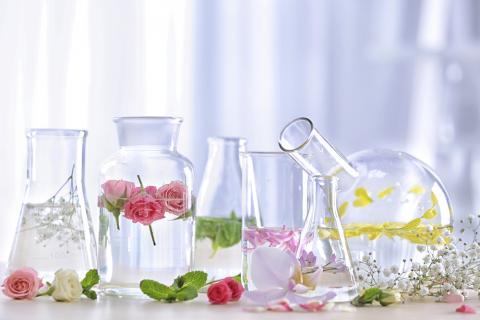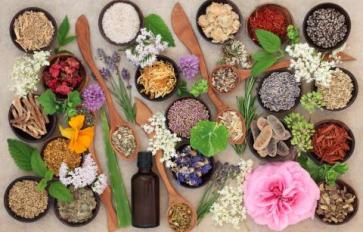
Are you as sensitive to regular, conventional perfume as I am? I literally start to sneeze whenever I catch a whiff of it. Even if it smells nice, it's as if my body knows it's all artificial and reacts to it. My nose has always been this way, even before I knew what the term “green beauty” meant. I guess it was just destiny (and a sensitive nose) that led me to more natural, greener beauty options. Instead of spraying myself with a bunch of artificial scents that incite an allergy attack, I prefer these plant perfumes instead. Sometimes I'll use floral waters (rose water is my favorite) when I'm in a pinch, but naturally made plant perfumes are stronger and have a longer lasting scent.
Plant perfumes don't require many ingredients, and they are really easy to make at home. In fact, they're even fun to make with kids. It's a great activity to do alone, or with a friend. I recommend hitting up a thrift shop for a pretty glass vial to hold your all-natural perfume in. You can find really beautiful ones sometimes for cheap, if you're lucky! Of course, you can always store it in a glass bottle of any kind if you're strapped for cash. Just make sure it has an airtight lid, or use a cork screw to seal it shut!
Why Artificial Fragrance Is Bad For You
If you're wondering why you should even attempt this DIY (besides it being fun), there are health reasons. Fragrance, a common ingredient found in most conventional perfumes, can cause respiratory, skin, eye, and even neurological health issues. According to a 2009 study called "Fragrance in the Workplace is the New Second-Hand Smoke," it's not the scent of fragrance so much as the synthetic chemicals in it that cause these problems. After all, these chemicals are derived from tar and petroleum. Icky, right? Worse yet, only 800 of the approximately 4,000 chemicals used as fragrances have been tested for toxicity, either alone or in combination with others. These chemicals proved to be so bad that the U.S. National Academy of Sciences has grouped fragrances with things like solvents, heavy metals, and even insecticides. Is that the sort of stuff you want to keep spraying on you? Didn't think so.
So please, take this opportunity to stop using conventional perfume and try all-natural ones instead. This DIY will help you, but don't stop there. Make some for your friends and family, or purchase some from trustworthy brands. Always read the ingredients before buying any perfume though, even if it does claim to be natural. You deserve to know what's in the items you're putting on your body. As soon as you see any chemicals listed, forget it. Stick to perfumes that have high standards, not high price tags. Your body will thank you! Now, without further ado, try making some natural perfume for yourself with this easy recipe.
Plant Perfume Recipe
Note: Don't use rubbing alcohol for this: It has too strong an odor. Use grain alcohol instead.
Ingredients
- grain alcohol
- 1 cup of good smelling flowers or leaves (such as dried rose petals, lavender leaves or flowers, mint leaves, jasmine flowers, and gardenia petals)
- small glass bottles with tight fitting caps
- for tags (optional): a pressed leaf or flower from the plant you used to make the perfume—use paper and clear self-adhesive paper for this
Directions
- Chop or cut the plant material into tiny pieces.
- Put the pieces in a small bottle, and add the grain alcohol. Be sure to fill the bottle completely, so there is very little air in it.
- Let the perfume sit for two weeks. Then uncap it and strain the perfume to remove the pieces of plant.
- Smell the perfume. If it smells like plant, recap the bottle and let it age for another week. If it doesn't smell strong enough, chop up some more of the plant, and let the perfume sit another two weeks.
- If you like, make a pretty label for your perfume with a pressed leaf or flower. Lay the pressed plant on a small square of paper, and then sandwich it between two small squares of clear contact paper. Punch a hole in the corner, thread a small ribbon or string through the hole, and tie it to the bottle.








